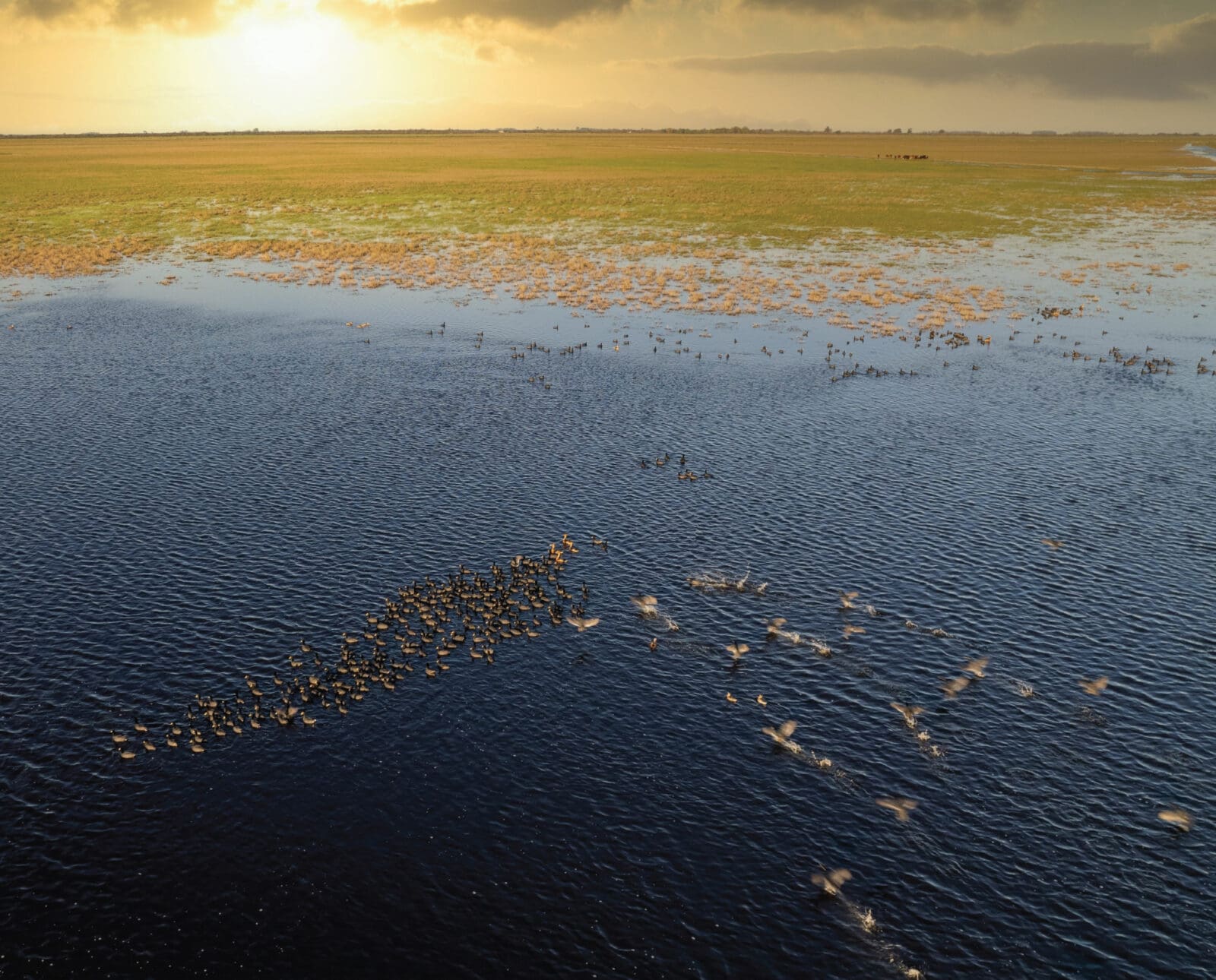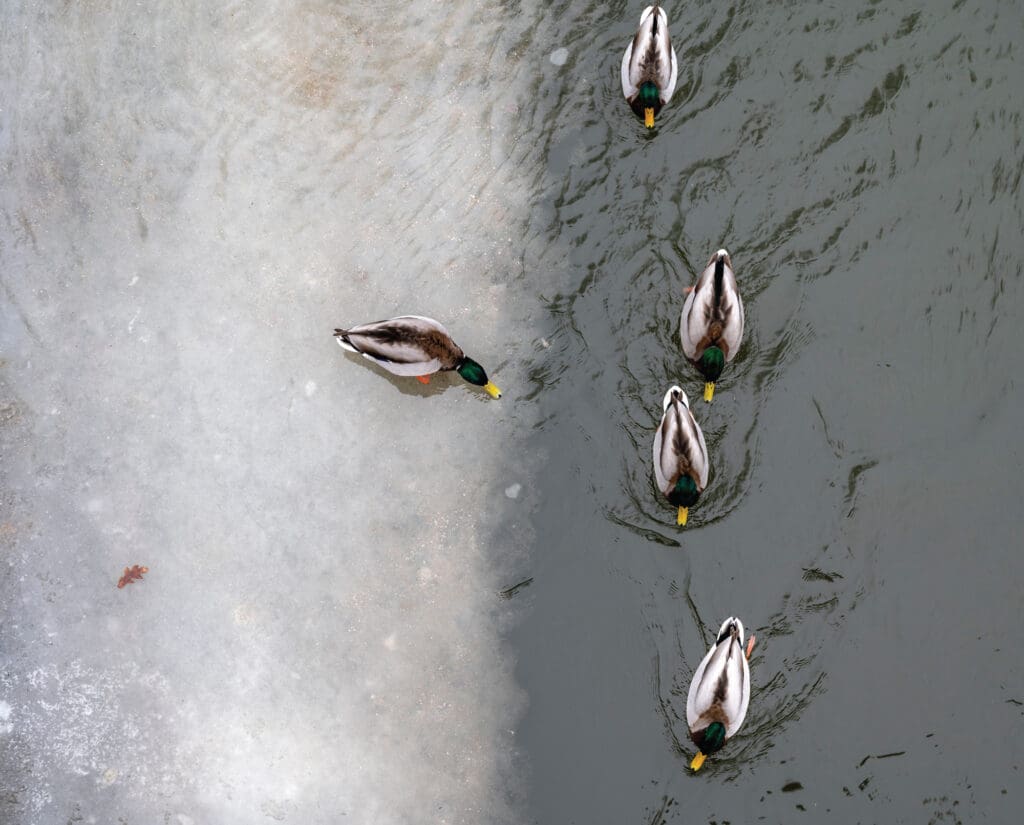Home » Waterfowl Hunting » How to E-Scout for Ducks
How to E-Scout for Ducks

Mike Adams is an outdoor writer, wildlife biologist, and educator…
Master the art of online duck scouting with our comprehensive guide. Discover digital tools and strategies to pinpoint prime hunting locations.
A good duck hunter speaks hail calls fluently, levels a shotgun in pouring rain, stays warm in pelting sleet, and stands firm in hurricane-force winds. These qualities go far for bagging a limit of ducks. Great duck hunters, however, fight half the battle from the comfort of their couch.
Listen to more articles on Apple | Google | Spotify | Audible
Great duck hunters approach the hunt like a college football coach approaches a National Championship game; they have a playbook and study it cover to cover. They know how to respond to the weather, have backup plans, and are prepared to handle anything the birds throw at them. Instead of hoping for victory, great duck hunters plan for it.
In football, they call this game preparation, but in duck hunting, they call this e-scouting. Platforms like OnX or Google Earth provide a duck’s-eye view of the landscape. From that perspective, you can see the ground just as a high-passing flock of teal would. To properly scout the land, you need to look at it the way the ducks do, and that boils down to finding food, cover, and travel lanes.
Locating Duck Cover and Food Online
Modern digital maps provide aerial imagery with vibrant, detailed color. A well-trained eye can use that detail to delineate where a phragmite patch ends and a cordgrass marsh begins. Even the most novice of e-scouters can make out the canopies of red cedars on the edge of a freshwater swamp. However, when dissecting digital maps for duck hunting, you need to leverage the high-quality imagery for what actually matters. Food and cover are number one.
Duck forage and thick cover reveal themselves through the shades of green and blue on the map. Big, dark blue bodies of water are often deep, with little available aquatic vegetation to serve as duck food. Remember, puddle ducks like mallards can only forage in waters less than about 16 inches deep.
A thin, sky-blue body of water likely means shallow water with plenty of forage. Sometimes, you can even see the mottled shades of algae-green mixed throughout. These micro-habitats will be filled with seeds, grains, leafy vegetation, snails, and other sorts of duck food.
Locate food to help narrow the scope of your hunt. If you can find a forage area adjacent to thick cover, highlight it in bold on your map. Thick cover offers two major advantages. First, cover provides a place for hunters to tuck in and hide from wary eyes in the sky. Second, areas with water next to thick vegetation attract ducks like rotten apples attract fruit flies. If you’ve ever studied waterfowl in a storm, you’ve probably noticed that they hate exposure. When the weather turns south, thick cover provides a wind break. That’s why ducks in high winds and rain will hang closer to the creek edges and may even hang up in some shallow, heavily vegetated water. Mark these areas on your map and hunt them on the eve of a fall or winter storm.

Identify Creek Junctions
The junction between two or more creeks checks off many boxes for duck hunters. First, these areas connect multiple waterfowl travel lanes. Set up in the crux of these travel lanes, and you’ve increased your odds of shooting exponentially. Second, these areas are extremely fertile. Currents collect silt, refuse, and decaying material as water runs downstream. All that fertile junk gets deposited at the stream mouth or its junction with other streams. The resulting build-up of organic material can create a point, or delta, rich with all the nutrients needed for thick vegetative growth. For a hunter, dense vegetative growth means good cover to hide. For a duck, thick vegetative growth means many seeds, and seeds mean survival.
Creek junctions are easy to find on the map. Simply scour any estuary system or freshwater drainage and look for where the creeks braid into each other. On a satellite map, you can glean more details, like the depth of the water as told by its shade of blue or the type of vegetative growth based on the color. Look for accessible junctions, points, or deltas among ducky-looking areas with lots of water, food, and cover and mark them on the map.
Plan for the Wind
The first commandment of duck hunting is always to have the wind blowing from your back. That’s because ducks like to land into the wind. It gives them more control and stability, and when they land into you instead of away from you, they offer cleaner, more ethical shots.
It’s important to keep that concept in mind when you’re e-scouting. In general, you want your decoys downwind from your blind location. Prevailing winds make this type of planning easy because you can simply look at an online map and plot out locations based on the prevailing wind direction in your area. From where I hunt in southern New Jersey, the prevailing wind direction generally wavers from southwest to northwest throughout the year. That gives me enough information to e-scout the marshes I hunt. If I can find thick cover with a body of water directly to its east, I can most likely hunt it with the wind to my back. Anytime I find areas like this, I mark them on my map. Then, I get out in my boat and spend a day checking them all for the quality of the habitat. I get bonus points if I flush birds.
Sometimes, however, the weather isn’t so predictable. Prevailing winds may blow from the west, but sometimes, an odd pressure system or storm will start blowing from the east. These can be some of the best times to hunt, and that’s why it’s important to plan for backup spots for every wind direction. Mark all these locations on your map, too.
Boots in the Mud
Every time I find a place on the map that gets me excited to hunt, I remind myself to spot-check it. Often, I’ll drop waypoints on public land like I’m hanging ornaments on a Christmas tree. My map will light up and bring me feelings of joy and optimism. Then, I’ll get out in the field and confront the reality that what I thought was great actually sucked. For example, nothing can ruin a hunt quicker than marking a boat ramp on your map just to find out, when you get there in the predawn darkness, that it’s been gated off and defunct for years.
Spot-checking has been and always will be the second step of e-scouting. E-scouting provides the scaffolding for your hunt, but a proper hunt plan cannot be completed without getting out in the field, double-checking your hunting areas, and finding real, live birds. Sometimes, it turns out how it did for me when I had to cancel my hunt plans because there was no usable boat ramp. Other times, the odds will turn the other way, and what you saw on the map is exactly what you wanted it to be: a red-hot waterfowl hunting honey-hole full of beautiful scenery, places to hide, and ducks galore.
Mike Adams is an outdoor writer, wildlife biologist, and educator hailing from salt marshes of the mid-Atlantic. His work has appeared in numerous outdoor publications, where he uses hunting and fishing narratives to explore deeper issues in conservation or ecology. In the fall, you'll find him on his Barnegat Bay Sneakbox hunting ducks with his dog, Boone. Any other time of year, he's usually out on the salt marsh, catching crabs or fishing for striper.




Mike ,
Your first 7 words of this article is way off . A hail call has nothing to do with being a good duck hunter . In fact , when a hunter blows a hail call , where I hunt , I can almost guarantee there won’t be a shoot fired .
A good duck caller will sound like their environment . Also , calling ducks is one variable of many that will determine a successful hunt .
Don’t post this stupid garbage. If you want to scout then do it traditionally. We don’t need to change the way we scout because it’s been effective for thousands of years without all of the e-crap. Don’t make scouting easy for the lazy generations. It takes real work. Remove this post!
One can only hope that you generated this comment “traditionally” and without any of the e-crap devices developed in the last thousand years. Real work, by the not-lazy generation, would require you to chisel it into stone and then ride a horse to deliver your written opinion to the author… right?
By that same token, I assume you only hunt with stones and other hand tools you made yourself? It was effective for thousands of years; technology only makes it easy for the lazy ones.